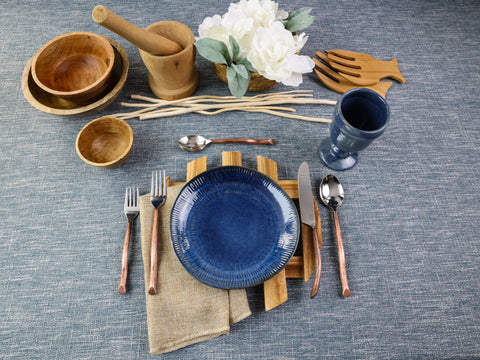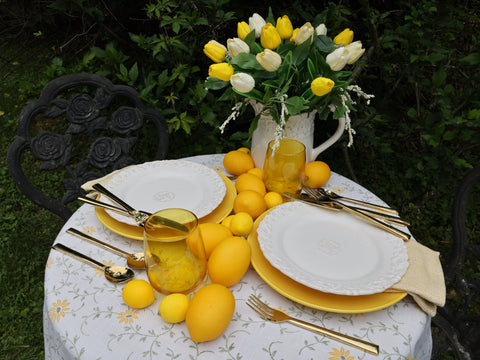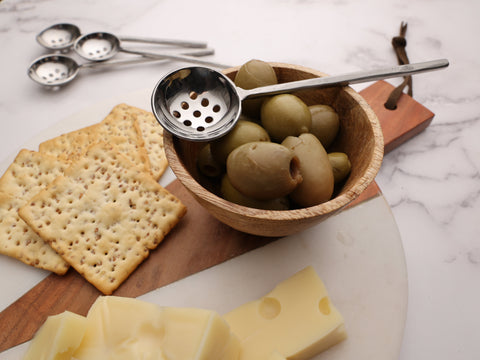In this blog post, we look at the Wabi Sabi philosophy. Known as the aesthetics of imperfection in the interior design world, we wanted to delve into what the philosophy teaches about seeing the beauty in modest, weathered…and well…imperfect things.
Learning about this ancient philosophy was an exciting journey with a new way of looking at what is considered elegant and authentic. Knowing that a hammered metal flatware set or a flatware design with a slightly rough, handcrafted feel works well in a Wabi Sabi setting, we set out to create a Wabi Sabi-inspired table setting.
We were delighted to discover that many of our handcrafted flatware sets are the perfect complement to this elegant aesthetic.
What is Wabi Sabi?
Wabi Sabi is an ancient Japanese philosophy that evolved from Japan’s Muromachi period. The Muromachi period, from 1336 to 1573, saw the emergence of certain art and cultural practices, like the Japanese tea ceremony, with an emphasis on Zen Buddhist principles.
Wabi Sabi combines two different concepts:
Wabi: Originally referred to living a simple, solitary life, which often meant living away from society. It embodies a lifestyle based on quietude and humility.
Wabi is about seeing the beauty in simplicity. It invites you to open your heart and opt for spiritual enrichment rather than the vanity of materialism.
Sabi: Concerned with the way things grow, age, and decay. It explores the beauty that comes with aging, wear, and the passage of time.
Sabi goes beyond the surface of what we see to realize the beauty that is hidden beneath.
Together, the concepts of Wabi and Sabi form a philosophy that anyone can adopt in their daily life by:
1. Embracing who we are
2. Finding beauty in simplicity
3. Accepting things as they come
In art, design, and everyday life, Wabi Sabi teaches us to appreciate the beauty in things that are simple, unique, and aged by time.
Wabi Sabi style

A Kintsugi Bowl - Photo by Matt Perkins on Unsplash
An iconic example of Wabi Sabi is the art of Kintsugi. It involves repairing broken pottery with gold or silver. Instead of trying to hide the cracks, they are highlighted as a beautiful part of the piece’s history. These pieces reflect the Wabi Sabi belief that as things age, they become more precious.

The Wabi-cha Japanese tea ceremony embraces the spirit of Wabi-Sabi. Photo via Pinterest.
The Wabi-cha style of Japanese tea ceremony celebrates simplicity and natural beauty over opulence. Wabi-cha invites participants to appreciate handmade, imperfect utensils, as well as being mindful of the experience. At a Wabi-cha tea ceremony, it is important to stay in the moment, as every gathering is unique and will never occur in the same way again.

Photo by Yan Krukau: https://www.pexels.com/photo/close-up-of-small-clay-bowls-6611432/
Japanese Wabi Sabi pottery revels in the organic nature of the creative process. The same appreciation for natural beauty and imperfection extends to Japanese Wabi Sabi ceramics, where unique shapes and vessels with uneven textures are celebrated.

A cozy Wabi Sabi style living room. Photo by: freepik.com
Wabi Sabi style in the home
A room designed with Wabi Sabi will feature a muted color palette, earthy textures, and simple forms. Imperfections like uneven floor boards or cracks in wood-paneled walls aren’t seen as flaws but as symbols of natural cycles of growth and decay.
The Wabi Sabi table setting: A handmade flatware set is the natural choice
When it comes to setting a Wabi Sabi-style table, a handmade flatware set is the perfect fit. Here's why:
Embracing imperfections. A textured flatware set, with its subtly uneven surfaces and distinctive patterns, personifies the Wabi Sabi philosophy.

Vinear flatware has round organic handles with linear grooves. The grooves enhance visual interest and provide a pleasant grip, while lending tactile pleasure to the dining experience.
Natural materials. Wabi Sabi often incorporates natural materials such as wood, stone, and metal. Each handmade silverware set in our collection is crafted from 18/8 grade stainless steel. Although stainless steel may not seem to align with the Wabi Sabi aesthetic at first glance, its durability and the unique patina that develops over time with everyday use complement this style well. What’s more, our hammered artisan flatware designs feature a vintage or aged look, making them a fitting choice for those who appreciate Wabi Sabi.

The richly distressed patina on each handle of the Ridge flatware set contrasts beautifully with the hand-polished, gleaming utensils. Just as Wabi Sabi finds beauty in the contrast between ceramic and silver, especially when used in the Japanese art of kintsugi, the contrast in the handles and utensils of each handcrafted silverware set makes it a perfect fit.
Handmade quality. Just as Wabi Sabi appreciates the natural differences in texture, form, and color of handmade ceramics, a handmade flatware set that showcases the maker’s touch with its characteristic textures and subtle variations is sure to resonate with this philosophy.

The Medicki vintage gold flatware set has a natural, organic feel. Each piece is handmade, with subtle differences that add to the warmth and authenticity of this table setting.
Contrast and balance. Wabi Sabi emphasizes natural textures above all. However, a well-curated table setting featuring a stainless steel flatware set, along with natural elements such as wooden or ceramic bowls and plates, complemented by simple neutral linens, can create a beautifully imperfect, unified table.
Our Wabi Sabi table setting

For our Wabi Sabi table setting, we chose a natural cotton tablecloth in blue and a neutral linen napkin. A dark blue ceramic plate with an embossed rim complements the ceramic wine goblet. A small wicker basket holds large white blossoms. Natural wooden elements abound with this tablescape, including a unique slatted charger, driftwood sticks, and the handcrafted Tondra Acacia Wood Bowls.

Inspired by nature, the artistic pairing of twig-like handles in earthy warm copper makes our Twig artisan flatware set the perfect complement to the Wabi Sabi style.
We hope we’ve inspired you to create your own Wabi Sabi style table settings. As for the Wabi Sabi philosophy, if we had to sum it up in one sentence, we would say it invites us to slow down and appreciate the imperfection and changes of the world around us.
🍵🪨🎋



